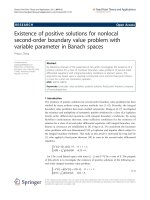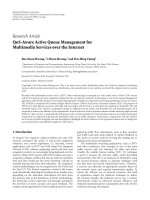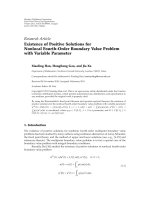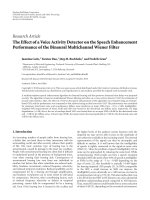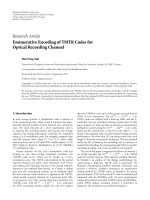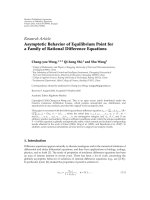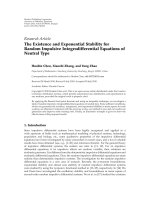Báo cáo hóa học: " Research Article The Existence of Positive Solutions for Third-Order p-Laplacian m-Point Boundary Value Problems with Sign Changing Nonlinearity on Time Scales" ppt
Bạn đang xem bản rút gọn của tài liệu. Xem và tải ngay bản đầy đủ của tài liệu tại đây (523.24 KB, 14 trang )
Hindawi Publishing Corporation
Advances in Difference Equations
Volume 2009, Article ID 169321, 14 pages
doi:10.1155/2009/169321
Research Article
The Existence of Positive Solutions for Third-Order
p-Laplacian m-Point Boundary Value Problems with
Sign Changing Nonlinearity on Time Scales
Fuyi Xu and Zhaowei Meng
School of Science, Shandong University of Technology, Zibo, Shandong 255049, China
Correspondence should be addressed to Fuyi Xu, xfy
Received 25 February 2009; Revised 10 April 2009; Accepted 2 June 2009
Recommended by Alberto Cabada
We study the following third-order p-Laplacian m-point boundary value problems on time scales
∇
m−2
Δ
a t f t, u t
0, t ∈ 0, T Tκ , u 0
0, φp uΔ∇ 0
φp uΔ∇
i 1 bi u ξi , u T
p−2
m−2
Δ∇
−1
ξi , where φp s is p-Laplacian operator, that is, φp s
|s| s, p > 1, φp
i 1 ci φp u
φq , 1/p 1/q
1, 0 < ξ1 < · · · < ξm−2 < ρ T . We obtain the existence of positive solutions by
using fixed-point theorem in cones. In particular, the nonlinear term f t, u is allowed to change
sign. The conclusions in this paper essentially extend and improve the known results.
Copyright q 2009 F. Xu and Z. Meng. This is an open access article distributed under the Creative
Commons Attribution License, which permits unrestricted use, distribution, and reproduction in
any medium, provided the original work is properly cited.
1. Introduction
The theory of time scales was initiated by Hilger 1 as a mean of unifying and extending
theories from differential and difference equations. The study of time scales has lead to
several important applications in the study of insect population models, neural networks,
heat transfer, and epidemic models, see, for example 2–6 . Recently, the boundary value
problems with p-Laplacian operator have also been discussed extensively in literature; for
example, see 7–18 . However, to the best of our knowledge, there are not many results
concerning the higher-order p-Laplacian mutilpoint boundary value problem on time scales.
A time scale T is a nonempty closed subset of R. We make the blanket assumption that
0, T are points in T. By an interval 0, T T , we always mean the intersection of the real interval
0, T with the given time scale; that is 0, T ∩ T.
In 19 , Anderson considered the following third-order nonlinear boundary value
problem BVP :
x t
x t1
x t2
f t, x t ,
0,
t1 ≤ t ≤ t3 ,
γx t3
δx t3
0.
1.1
2
Advances in Difference Equations
author studied the existence of solutions for the nonlinear boundary value problem by
using Krasnoselskii’s fixed point theorem and Leggett and Williams fixed point theorem,
respectively.
In 9, 10 , He considered the existence of positive solutions of the p-Laplacian dynamic
equations on time scales
φp uΔ
∇
a t f ut
0,
t ∈ 0, T
T,
1.2
satisfying the boundary conditions
u 0 − B 0 uΔ η
0,
uΔ T
0,
1.3
0,
1.4
or
uΔ 0
0,
u T − B 1 uΔ η
where η ∈ 0, ρ T . He obtained the existence of at least double and triple positive solutions
of the problems by using a new double fixed point theorem and triple fixed point theorem,
respectively.
In 18 , Zhou and Ma firstly studied the existence and iteration of positive solutions for
the following third-order generalized right-focal boundary value problem with p-Laplacian
operator
φp u
t
q t f t, u t ,
0 ≤ t ≤ 1,
m
u0
i 1
1.5
n
αi u ξi ,
u n
0,
βi u θi .
u 1
i 1
They established a corresponding iterative scheme for the problem by using the monotone
iterative technique.
All the above works were done under the assumption that the nonlinear term is
nonnegative. The key conditions used in the above papers ensure that positive solution
is concave down. If the nonlinearity is negative somewhere, then the solution needs no
longer to be concave down. As a result, it is difficult to find positive solutions of the pLaplacian equation when the nonlinearity changes sign. In particular, little work has been
done on the existence of positive solutions for higher order p-Laplacian m-point boundary
value problems with nonlinearity f being nonnegative on time scales. Therefore, it is a
natural problem to consider the existence of positive solution for higher order p-Laplacian
equations with sign changing nonlinearity on time scales. This paper attempts to fill this gap
in literature.
Advances in Difference Equations
3
In this paper, by using different method, we are concerned with the existence
of positive solutions for the following third-order p-Laplacian m-point boundary value
problems on time scales:
∇
φp uΔ∇
m−2
Δ
bi u ξi ,
u 0
a t f t, u t
u T
0,
φp u
0,
Δ∇
t ∈ 0, T
m−2
ci φp u
0
i 1
1.6
Δ∇
ξi
,
i 1
where φp s is p-Laplacian operator, that is, φp s
and bi , ci , a, f satisfy
H1
Tκ ,
−1
|s|p−2 s, p > 1, φp
bi , ci ∈ 0, ∞ , 0 < ξ1 < · · · < ξm−2 < ρ T , 0 <
H2 f : 0, T Tκ × 0, ∞
there exists t0 ∈ 0, T
m−2
i 1
bi < 1, 0 <
φq , 1/p
m−2
i 1 ci
→ −∞, ∞ is continuous, a ∈ Cld 0, T
such that a t0 > 0.
Tκ ,
1/q
1,
< 1;
0, ∞ , and
Tκ
2. Preliminaries and Lemmas
For convenience, we list the following definitions which can be found in 1–5 .
Definition 2.1. A time scale T is a nonempty closed subset of real numbers R. For t < supT and
r > inf T, define the forward jump operator σ and backward jump operator ρ, respectively,
by
σ t
inf{τ ∈ T | τ > t} ∈ T,
ρ r
sup{τ ∈ T | τ < r} ∈ T
2.1
for all t, r ∈ T. If σ t > t, t is said to be right scattered, if ρ r < r, r is said to be left scattered;
if σ t
t, t is said to be right dense, and if ρ r
r, r is said to be left dense. If T has a right
T − {m}; otherwise set Tk
T. If T has a left scattered
scattered minimum m, define Tk
maximum M, define Tk T − {M}; otherwise set Tk T.
Definition 2.2. For f : T → R and t ∈ Tk , the delta derivative of f at the point t is defined to
be the number f Δ t provided that it exists , with the property that for each > 0, there is a
neighborhood U of t such that
f σ t
− f s − fΔ t σ t − s
≤ |σ t − s|
2.2
for all s ∈ U.
For f : T → R and t ∈ Tk , the nabla derivative of f at t, denoted by f ∇ t provided it
exists with the property that for each > 0, there is a neighborhood U of t such that
f ρ t
for all s ∈ U.
− f s − f∇ t ρ t − s
≤
ρ t −s
2.3
4
Advances in Difference Equations
Definition 2.3. A function f is left-dense continuous i.e., ld-continuous , if f is continuous at
each left-dense point in T and its right-sided limit exists at each right-dense point in T.
Definition 2.4. If φΔ t
f t , then we define the delta integral by
b
f t Δt
φ b −φ a .
2.4
a
If F ∇ t
f t , then we define the nabla integral by
b
f t ∇t
F b −F a .
2.5
a
Lemma 2.5. If condition H1 holds, then for h ∈ Cld 0, T
uΔ∇
Tκ ,
0,
t ∈ 0, T
bi u ξi ,
uΔ T
h t
m−2
u 0
the boundary value problem (BVP)
Tκ ,
2.6
0
i 1
has the unique solution
t
u t
T − s h s ∇s
m−2
i 1
bi
ξi
0
T − s h s ∇s
1−
0
m−2
i 1
bi
.
2.7
Proof. By caculating, we can easily get 2.7 . So we omit it.
Lemma 2.6. If condition H1 holds, then for h ∈ Cld 0, T
φp uΔ∇
m−2
bi u ξi ,
u0
∇
h t
Δ
u T
0,
the boundary value problem (BVP)
t ∈ 0, T
0,
φp u
Tκ ,
Δ∇
Tκ ,
m−2
ci φp u
0
i 1
2.8
Δ∇
ξi
i 1
has the unique solution
t
u t
T − s φq
0
where C
ξi
m−2
i 1 ci 0 h
s
h r ∇r
C ∇s
0
r ∇r/ 1 −
m−2
i 1 ci
.
m−2
i 1
bi
ξi
0
s
h r
0
m−2
i 1 bi
T − s φq
1−
∇r
C ∇s
,
2.9
Advances in Difference Equations
5
Proof. Integrating both sides of equation in 2.8 on 0, t , we have
φp uΔ∇ t
φp uΔ∇ 0
−
t
h r ∇r.
2.10
0
So,
φp uΔ∇ ξi
φp uΔ∇ 0
−
ξi
h r ∇r.
2.11
0
By boundary value condition φp uΔ∇ 0
φp u
Δ∇
uΔ∇ ξi , we have
m−2
i 1 ci φp
ξi
m−2
i 1 ci 0 h r ∇r
.
1 − m−2 ci
i 1
−
0
2.12
By 2.10 and 2.12 we know
⎛
uΔ∇ t
−φq ⎝
ξi
m−2
i 1 ci 0 h r ∇r
1 − m−2 ci
i 1
t
⎞
h r ∇r ⎠.
2.13
0
This together with Lemma 2.5 implies that
t
ut
T − s φq
0
where C
s
h r ∇r
m−2
i 1
C ∇s
bi
ξi
0
1−
0
ξi
m−2
i 1 ci 0 h
r ∇r/ 1 −
m−2
i 1 ci
s
h r
0
m−2
i 1 bi
T − s φq
∇r
C ∇s
,
2.14
. The proof is complete.
Lemma 2.7. Let condition H1 holds If h ∈ Cld 0, T
of 2.8 satisfies
u t ≥ 0,
Tκ
and h t ≥ 0, then the unique solution u t
t ∈ 0, T
Tκ .
ξ
2.15
t
Proof. By uΔ∇ t
−φq m−2 ci 0i h r ∇r/ 1 − m−2 ci
h r ∇r ≤ 0, we can know that
i 1
i 1
0
the graph of u t is concave down on 0, T Tκ , and uΔ t is nonincreasing on 0, T Tκ . This
together with the assumption that the boundary condition uΔ T
0 implies that uΔ t ≥ 0
for t ∈ 0, T Tκ . This implies that
min u t
t∈ 0,T
Tκ
u 0.
2.16
6
Advances in Difference Equations
So we only prove u 0 ≥ 0. By condition H1 we have
u0
m−2
i 1
bi
ξi
0
s
h r
0
m−2
i 1 bi
T − s φq
1−
∇r
C ∇s
≥ 0.
2.17
The proof is completed.
Lemma 2.8. Let condition H1 hold. If h ∈ Cld 0, T
solution u t of (BVP) 2.8 satisfies
and h t ≥ 0, then the unique positive
Tκ
inf u t ≥ σ1 u ,
t∈ 0,T
where σ1
m−2
i 1
bi ξi / T −
m−2
i 1
2.18
Tκ
bi T − ξi , u
supt∈ 0,T
Tκ
ξ
|u t |.
t
Proof. By uΔ∇ t
−φq m−2 ci 0i h r ∇r/ 1 − m−2 ci
h r ∇r ≤ 0, we can know that
i 1
i 1
0
the graph of u t is concave down on 0, T Tκ , and uΔ t is nonincreasing on 0, T Tκ . This
0 implies that uΔ t ≥ 0
together with the assumption that the boundary condition uΔ T
for t ∈ 0, T Tκ . This implies that
u
u T ,
min u t
t∈ 0,T
u 0.
Tκ
2.19
For all i ∈ {1, 2, . . . , m − 2}, we have from the concavity of u that
u ξi − u 0
u T −u 0
,
≥
ξi
T
2.20
that is,
u ξi − u 0
ξi
ξi
u0 ≥ u T .
T
T
This together with the boundary condition u 0
min u t ≥
t∈ 0,T
Tκ
T−
m−2
i 1
m−2
i 1 bi ξi
m−2
i 1 bi T
2.21
bi u ξi implies that
− ξi
u T .
2.22
This completes the proof.
Let E Cld 0, T Tκ be endowed with the ordering x ≤ y if x t ≤ y t for all t ∈ 0, T Tκ ,
and u
maxt∈ 0,T Tκ |u t | is defined as usual by maximum norm. Clearly, it follows that
E, u is a Banach space.
Advances in Difference Equations
7
For the convenience, let
⎛
φq ⎝
ψ s
s
⎞
ξi
m−2
i 1 ci 0 a r ∇r ⎠
.
1 − m−2 ci
i 1
a r ∇r
0
2.23
We define two cones by
P
K
{u : u ∈ E, u t ≥ 0, t ∈ 0, T
u : u ∈ E, u t is concave, nonincreasing and nonnegative on 0, T
min u t ≥ σ u
t∈ 0,T
where σ
σ2
Tκ },
Tκ
Tκ
2.24
.
2.25
,
σ1 σ2 , σ1 is defined in Lemma 2.8 and
m−2
i 1
1−
m−2
i 1
bi
T
0
bi
ξi
ψ
0
s ∇s
m−2
i 1
T − s ψ T ∇s
bi
ξi
ψ
0
m−2
i 1
T ∇s/ 1 −
bi
Define the operators F : P → E and S : K → E by setting
t
Fu t
T − s φq
0
s
a r f r, u r ∇r
m−2
i 1
bi
ξi
0
T − s φq
s
a
0
ξi
m−2
i 1 ci 0 a
r f r, u r ∇r/ 1 −
t
Su t
m−2
i 1 ci
T − s ϕ s ∇s
0
s
r f r, u r ∇r
m−2
i 1
1−
where A
A ∇s
0
A ∇s
bi
2.26
,
,
m−2
i 1
bi
1−
ξi
ϕ s ∇s
0
,
m−2
i 1 bi
2.27
ξ
m−2
m−2
i
where ϕ s
φq 0 a r f r, u r ∇r A , A
i 1 ci 0 a r f r, u r ∇r/ 1 −
i 1 ci , and
max{f t, u t , 0}. Obviously, u is a solution of the BVP 1.6 if and only if u is a
f t, u t
fixed point of operator F.
Lemma 2.9. S : K → K is completely continuous.
Proof. It is easy to see that SK ⊂ K by f ≥ 0 and Lemma 2.8. By Arzela-Ascoli theorem and
Lebesgue dominated convergence theorem, we can easily prove that operator S is completely
continuous.
8
Advances in Difference Equations
Lemma 2.10 see 20, 21 . Let K be a cone in a Banach space X. Let D be an open bounded subset
of X with DK D ∩ K / ∅ and DK / K. Assume that A : DK → K is a compact map such that
x / Ax for x ∈ ∂DK . Then the following results hold.
1 If Ax ≤ x , x ∈ ∂DK , then iK A, DK
1.
2 If there exists x0 ∈ K \ {0} such that x / Ax
0.
iK A, DK
λx0 for all x ∈ ∂DK and all λ > 0, then
1 and iK A, UK
0, then A has a
3 Let U be open in X such that U ⊂ DK . If iK A, DK
0 and iK A, UK
1, where
fixed point in DK \ UK . The same result holds if iK A, DK
iK A, DK denotes fixed point index.
We define
Kρ
u t ∈K: u <ρ ,
Ωρ
u t ∈ K : min u t < σρ .
t∈ 0,T
2.28
Tκ
Lemma 2.11 see 20 . Ωρ defined above has the following properties:
a Kσρ ⊂ Ωρ ⊂ Kρ ;
b Ωρ is open relative to K;
c u ∈ ∂Ωρ if and only if mint∈ 0,T
Tκ
u t
σρ;
d if u ∈ ∂Ωρ , then σρ ≤ u t ≤ ρ for t ∈ 0, T
Tκ .
For the convenience, we introduce the following notations:
1
m
T
m−2
i 1
T − s ψ T ∇s
bi
1−
0
ξi
ψ T
0
m−2
i 1 bi
∇s
1
M
,
Remark 2.12. By H1 we can know that 0 < m, M < ∞, Mσ
m−2
i 1
bi
1−
ξi
ψ s ∇s
0
.
m−2
i 1 bi
Mσ1 σ2
2.29
mσ1 < m.
Lemma 2.13. If f satisfies the following condition :
f t, u ≤ φp mρ ,
t, u ∈ 0, T
Tκ
× 0, ρ , u / Su, u ∈ ∂Kρ ,
2.30
1.
2.31
then
iK S, Kρ
Proof. For u ∈ ∂Kρ , then from 2.30 we have
s
0
a r f r, u r ∇r
s
A
a r f r, u r ∇r
0
⎛
≤ φp mρ ⎝
T
0
a r ∇r
ξi
m−2
i 1 ci 0 a
1−
r f r, u r ∇r
m−2
i 1 ci
⎞
ξi
m−2
i 1 ci 0 a r ∇r ⎠
.
1 − m−2 ci
i 1
2.32
Advances in Difference Equations
9
So that
s
ϕs
φq
a r f r, u r ∇r
≤ mρψ T .
A
2.33
0
Therefore,
Su t ≤
T
m−2
i 1
T − s ϕ s ∇s
1−
0
⎛
≤ mρ⎝
T
ξi
ϕ s ∇s
0
m−2
i 1 bi
bi
m−2
i 1
T − s ψ T ∇s
bi
1−
0
ξi
ψ T
0
m−2
i 1 bi
∇s
⎞
⎠
2.34
ρ.
This implies that Su ≤ u for u ∈ ∂Kρ . Hence by Lemma 2.10 1 it follows that iK S, Kρ
1.
Lemma 2.14. If f satisfies the following condition:
f t, u ≥ φp Mσρ ,
t, u ∈ 0, T
Tκ
× σρ, ρ , u / Su, u ∈ ∂Ωρ ,
2.35
0.
2.36
then
iK S, Ωρ
Proof. Let e t ≡ 1 for t ∈ 0, T
Tκ .
Then e ∈ ∂K1 . We claim that
u / Su
λe,
u ∈ ∂Ωρ , λ > 0.
In fact, if not, there exist u0 ∈ ∂Ωρ and λ0 > 0 such that u0
we have
s
0
a r f r, u0 r ∇r
s
A
a r f r, u0 r ∇r
0
⎛
≥ φp Mσρ ⎝
s
0
a r ∇r
2.37
Su0 λ0 e. By f t, u0 ≥ φp Mσρ ,
ξi
m−2
i 1 ci 0 a
1−
r f r, u0 r ∇r
m−2
i 1 ci
⎞
ξi
m−2
i 1 ci 0 a r ∇r ⎠
.
1 − m−2 ci
i 1
2.38
10
Advances in Difference Equations
So that
s
ϕ s
φq
0
a r f r, u0 r ∇r
⎛
s
≥ Mσρφq ⎝
A
⎞
ξi
m−2
i 1 ci 0 a r ∇r ⎠
1 − m−2 ci
i 1
a r ∇r
0
2.39
Mσρψ s .
For t ∈ 0, T
Tκ ,
then
u0 t
λ0 e t
Su0 t
≥ Su0 0
m−2
i 1
λ0
bi
1−
≥
ξi
ϕ
0
m−2
i 1
σρ
m−2
i 1
bi
λ0
bi
ξi
m−2
Mσρ
1−
s ∇s
bi
i 1
ψ s ∇s
2.40
λ0
0
λ0 .
This together with Lemma 2.11 c implies that
σρ ≥ σρ
λ0 ,
a contradiction. Hence by Lemma 2.10 2 it follows that iK S, Ωρ
2.41
0.
3. Main Results
We now give our results on the existence of positive solutions of BVP 1.6 .
Theorem 3.1. Suppose that conditions H1 and H2 hold, and assume that one of the following
conditions holds.
H3 There exist ρ1 , ρ2 ∈ 0, ∞ with ρ1 < σρ2 such that
i f t, u ≤ φp mρ1 , t, u ∈ 0, T Tκ × 0, ρ1 ;
ii f t, u ≥ 0, t, u ∈ 0, T Tκ × σρ1 , ρ2 , moreover f t, u ≥ φp Mσρ2 , t, u ∈
0, T Tκ × σρ2 , ρ2 .
H4 There exist ρ1 , ρ2 ∈ 0, ∞ with ρ1 < ρ2 such that
i f t, u ≤ φp mρ2 , t, u ∈ 0, T Tκ × 0, ρ2 ;
ii f t, u ≥ φp Mσρ1 , t, u ∈ 0, T Tκ × σ 2 ρ1 , ρ2 .
Then, the BVP 1.6 has at least one positive solution.
Advances in Difference Equations
11
Proof. Assume that H3 holds, we show that S has a fixed point u1 in Ωρ2 \ K ρ1 . By f t, u ≤
φp mρ1 and Lemma 2.13, we have that
iK S, Kρ1
1.
3.1
By f t, u ≥ φp Mσρ2 and Lemma 2.14, we have that
iK S, Ωρ2
0.
3.2
By Lemma 2.11 a and ρ1 < σρ2 , we have K ρ1 ⊂ Kσρ2 ⊂ Ωρ2 . It follows from Lemma 2.10 3
that S has a fixed point u1 in Ωρ2 \ K ρ1 . Clearly,
u1 > ρ 1 ,
min u1 t ≥ σ u1 > σρ1 ,
t∈ 0,T
3.3
Tκ
which implies that σρ1 ≤ u1 t ≤ ρ2 , t ∈ 0, T Tκ . By condition H3 ii , we have f t, u1 t
f t, u1 t . Hence,
t ∈ 0, T Tκ , that is, f t, u1 t
Fu1
Su1 .
≥ 0,
3.4
This means that u1 is a fixed point of operator F.
When condition H4 holds, by f t, u ≤ φp mρ2 and Lemma 2.13, we have that
iK S, Kρ2
1.
3.5
By f t, u ≥ φp Mσρ1 and Lemma 2.14, we have that
iK S, Ωρ1
0.
3.6
By Lemma 2.11 a and ρ1 < ρ2 , we have K σρ1 ⊂ Ωρ1 ⊂ Kρ2 . It follows from Lemma 2.10 3
that S has a fixed point u2 in Kρ2 \ Ωρ1 . Obviously,
u2 > σρ1 ,
min u2 t ≥ σ u2 > σ 2 ρ1 ,
t∈ 0,T
3.7
Tκ
which implies that σ 2 ρ1 ≤ u2 t ≤ ρ2 , t ∈ 0, T Tκ . By condition H4 ii , we have f t, u2 t
f t, u2 t . Hence,
0, t ∈ 0, T Tκ , that is, f t, u2 t
Fu2
Su2 .
≥
3.8
This means that u2 is a fixed point of operator F. Therefore, the BVP 1.6 has at least one
positive solution.
12
Advances in Difference Equations
Theorem 3.2. Assume that conditions H1 and H2 hold, and suppose that one of the following
conditions holds.
H5 There exist ρ1 , ρ2 , and ρ3 ∈ 0, ∞ with ρ1 < σρ2 , and ρ2 < ρ3 such that
i f t, u ≤ φp mρ1 , t, u ∈ 0, T Tκ × 0, ρ1 ;
ii f t, u ≥ 0, t, u ∈ 0, T Tκ × σρ1 , ρ3 , moreover f t, u ≥ φp Mσρ2 , t, u ∈
0, T Tκ × σρ2 , ρ2 , u / Su, ∀u ∈ ∂Ωρ2 ;
iii f t, u ≤ φp mρ3 , t, u ∈ 0, T Tκ × 0, ρ3 .
H6 There exist ρ1 , ρ2 , and ρ3 ∈ 0, ∞ with ρ1 < ρ2 < σρ3 such that
i f t, u ≥ φp Mσρ1 , t, u ∈ 0, T Tκ × σ 2 ρ1 , ρ2 ;
ii f t, u ≤ φp m1 ρ2 , t, u ∈ 0, T Tκ × 0, ρ2 , u / Su, ∀u ∈ ∂Kρ2 ;
iii f t, u ≥ 0, t, u ∈ 0, T Tκ × σρ2 , ρ3 , moreover, f t, u ≥ φp Mσρ3 , t, u ∈
0, T Tκ × σρ3 , ρ3 .
Then, the BVP 1.6 has at least two positive solutions.
Proof. Assume that condition H5 holds, we show that S has a fixed point u1 either in ∂Kρ1
or in Ωρ2 \ K ρ1 . If u / Su for u ∈ ∂Kρ1 ∪ ∂Kρ3 . by Lemmas 2.13 and 2.14, we have that
iK S, Kρ1
1,
iK S, Kρ3
1,
iK S, Ωρ2
0.
3.9
By Lemma 2.11 a and ρ1 < σρ2 , we have K ρ1 ⊂ Kσρ2 ⊂ Ωρ2 . It follows from Lemma 2.10 3
that S has a fixed point u1 in Ωρ2 \ K ρ1 . Similarly, S has a fixed point u2 in Kρ3 \ Ωρ2 . Clearly,
u1 > ρ1 ,
min u1 t ≥ σ u1 > σρ1 ,
t∈ 0,T
3.10
Tκ
which implies that σρ1 ≤ u1 t ≤ ρ2 , t ∈ 0, T Tκ . By condition H5 ii , we have f t, u1 t
f t, u1 t . Hence,
t ∈ 0, T Tκ , that is, f t, u1 t
Fu1
Su1 .
≥ 0,
3.11
This means that u1 is a fixed point of operator F. On the other hand, from u2 ∈ Kρ3 \ Ωρ2 , ρ2 <
ρ3 and Lemma 2.11 a , we have Kσρ2 ⊂ Ωρ2 ⊂ Kρ3 . Clearly,
u2 > σρ2 ,
min u2 t ≥ σ u2 > σ 2 ρ2 ,
t∈ 0,T
3.12
Tκ
which implies that σ 2 ρ2 ≤ u2 t ≤ ρ3 , t ∈ 0, T Tκ . By ρ1 < σρ2 and condition H5 ii , we
f t, u2 t . Hence,
have f t, u2 t ≥ 0, t ∈ 0, T Tκ , that is, f t, u2 t
Fu2
Su2 .
3.13
Advances in Difference Equations
13
This means that u2 is a fixed point of operator F. Then, the BVP 1.6 has at least two positive
solutions.
When condition H6 holds, the proof is similar to the above, and so we omit it here.
4. An Example
In the section, we present some simple examples to explain our results.
Example 4.1. Let T
0, 1/2
problem with p-Laplacian
{1}, T
∇
φp uΔ∇
u 0
1
1
u
,
3
2
1. Consider the following three-point boundary value
Δ
u 1
a t f t, u
0,
φp u
0,
Δ∇
0 < t < 1,
4.1
1
1
φp uΔ∇
4
2
0
,
where a t ≡ 1, b1 1/3, c1 1/4, ξ1 1/2, p q 2.
By computing, we can know σ1 1/5, σ2 1/7, M 48/5, m 48/35. Obviously,
σ σ1 σ2 1/35, Mσ 48/5 × 1/35 < 48/35 m.
Let ρ1 1, ρ2 78, then σρ1 < ρ1 < σρ2 < ρ2 . We define a sign changing nonlinearity
as follows:
f t, u
⎧ 3
1 3
⎪ 48t
⎪
⎪
⎪ 35 u − 35 ,
⎪
⎪
⎪
⎪
⎪
⎪ 3
⎪ 48t
⎪
35 π
1 π
⎪
⎪
sin
u−
,
⎪
⎪
⎪ 35
34 2
34 2
⎪
⎪
⎪
⎪
⎨ 3
48t
3744
u−1 ,
⎪ 35 2 − u
⎪
175
⎪
⎪
⎪
⎪
⎪
⎪ 3744
⎪
⎪
⎪
t3 u − 2 2 ,
⎪
⎪
⎪ 175
⎪
⎪
⎪
⎪
⎪
⎪ 3744
⎪
⎩
t3 78 − 2 2 1 u − 78 ,
175
0 < t < 1, u ∈ 0,
0 < t < 1, u ∈
1
,
35
1
,1 ,
35
0 < t < 1, u ∈ 1, 2 ,
4.2
0 < t < 1, u ∈ 2, 78 ,
0 < t < 1, u ∈ 78, ∞ .
Then, by the definition of f we have
i f t, u ≤ φp mρ1
48/35, t, u ∈ 0, 1 × 0, ρ1 ;
ii f t, u ≥ 0, t, u ∈ 0, 1 × σρ1 , ρ2 , moreover f t, u ≥ φp Mσρ2
t, u ∈ 0, 1 × σρ2 , ρ2 .
3744/175,
So condition H3 holds, and by Theorem 3.1, BVP 4.1 has at least one positive
solution.
14
Advances in Difference Equations
Acknowledgment
This project was supported by the National Natural Science Foundation of China 10471075,
10771117 .
References
1 S. Hilger, “Analysis on measure chains—a unified approach to continuous and discrete calculus,”
Results in Mathematics, vol. 18, no. 1-2, pp. 18–56, 1990.
2 R. P. Agarwal and D. O’Regan, “Nonlinear boundary value problems on time scales,” Nonlinear
Analysis: Theory, Methods & Applications, vol. 44, no. 4, pp. 527–535, 2001.
3 F. M. Atici and G. Sh. Guseinov, “On Green’s functions and positive solutions for boundary value
problems on time scales,” Journal of Computational and Applied Mathematics, vol. 141, no. 1-2, pp. 75–99,
2002.
4 H.-R. Sun and W.-T. Li, “Positive solutions for nonlinear three-point boundary value problems on
time scales,” Journal of Mathematical Analysis and Applications, vol. 299, no. 2, pp. 508–524, 2004.
5 M. Bohner and A. Peterso, Eds., Advances in Dynamic Equations on Time Scales, Birkhă user, Boston,
a
Mass, USA, 2003.
6 H. R. Sun and W. T. Li, “Positive solutions for nonlinear m-point boundary value problems on time
scales,” Acta Mathematica Sinica, vol. 49, no. 2, pp. 369–380, 2006 Chinese .
7 H.-R. Sun and W.-T. Li, “Existence theory for positive solutions to one-dimensional p-Laplacian
boundary value problems on time scales,” Journal of Differential Equations, vol. 240, no. 2, pp. 217–
248, 2007.
8 Y.-H. Su, W.-T. Li, and H.-R. Sun, “Triple positive pseudo-symmetric solutions of three-point BVPs
for p-Laplacian dynamic equations on time scales,” Nonlinear Analysis: Theory, Methods & Applications,
vol. 68, no. 6, pp. 1442–1452, 2008.
9 Z. He, “Double positive solutions of three-point boundary value problems for p-Laplacian dynamic
equations on time scales,” Journal of Computational and Applied Mathematics, vol. 182, no. 2, pp. 304–315,
2005.
10 Z. He and X. Jiang, “Triple positive solutions of boundary value problems for p-Laplacian dynamic
equations on time scales,” Journal of Mathematical Analysis and Applications, vol. 321, no. 2, pp. 911–920,
2006.
11 F. Y. Xu, “Positive solutions for third-order nonlinear p-Laplacian m-point boundary value problems
on time scales,” Discrete Dynamics in Nature and Society, vol. 2008, Article ID 143040, 16 pages, 2008.
12 Y. H. Su, S. Li, and C. Huang, “Positive solution to a singular p-Laplacian BVPs with sign-changing
nonlinearity involving derivative on time scales,” Advances in Difference Equations, vol. 2009, Article
ID 623932, 21 pages, 2009.
13 Y. H. Su and W. T. Li, “Existence of positive solutions to a singular p-Laplacian dynamic equations
with sign changing nonlinearity,” Acta Mathematica Scientia, vol. 52, pp. 181–196, 2009 Chinese .
14 F. Y. Xu, “Positive solutions for multipoint boundary value problems with one-dimensional pLaplacian operator,” Applied Mathematics and Computation, vol. 194, no. 2, pp. 366–380, 2007.
15 Y. H. Su and W. T. Li, “Existence of positive solutions to a singular p-Laplacian dynamic equations
with sign changing nonlinearity,” Acta Mathematica Scientia, vol. 28, pp. 51–60, 2008 Chinese .
16 Y.-H. Su, “Multiple positive pseudo-symmetric solutions of p-Laplacian dynamic equations on time
scales,” Mathematical and Computer Modelling, vol. 49, no. 7-8, pp. 1664–1681, 2009.
17 Y.-H. Su, W.-T. Li, and H.-R. Sun, “Positive solutions of singular p-Laplacian BVPs with sign changing
nonlinearity on time scales,” Mathematical and Computer Modelling, vol. 48, no. 5-6, pp. 845–858, 2008.
18 C. Zhou and D. Ma, “Existence and iteration of positive solutions for a generalized right-focal
boundary value problem with p-Laplacian operator,” Journal of Mathematical Analysis and Applications,
vol. 324, no. 1, pp. 409–424, 2006.
19 D. R. Anderson, “Green’s function for a third-order generalized right focal problem,” Journal of
Mathematical Analysis and Applications, vol. 288, no. 1, pp. 1–14, 2003.
20 K. Q. Lan, “Multiple positive solutions of semilinear differential equations with singularities,” Journal
of the London Mathematical Society, vol. 63, no. 3, pp. 690–704, 2001.
21 D. J. Guo and V. Lakshmikantham, Nonlinear Problems in Abstract Cones, vol. 5 of Notes and Reports in
Mathematics in Science and Engineering, Academic Press, Boston, Mass, USA, 1988.

